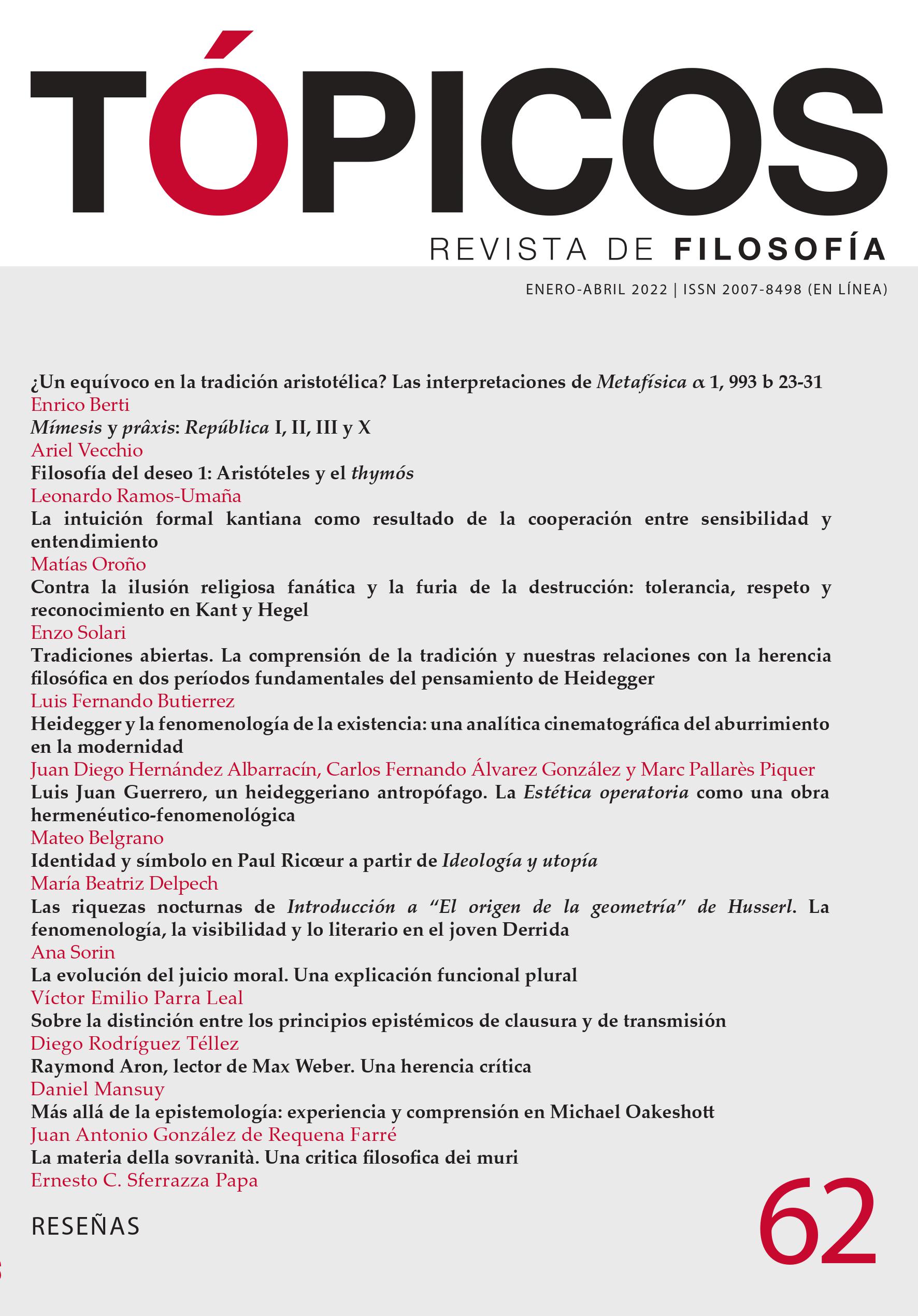Publicado 2021-12-11
Palabras clave
- Kant,
- intuición formal,
- forma de la intuición,
- sensibilidad,
- entendimiento
Derechos de autor 2021 Tópicos, Revista de Filosofía

Esta obra está bajo una licencia internacional Creative Commons Atribución-NoComercial-SinDerivadas 4.0.
Cómo citar
Resumen
El objetivo principal de este artículo es ofrecer una interpretación sobre la noción kantiana de “intuición formal”, la cual admite una distinción analítica respecto del concepto de “forma de la intuición”. Defiendo que la intuición formal es el resultado del entrecruzamiento entre la sensibilidad y el entendimiento en tanto facultades mutuamente irreductibles. De este modo, se subraya la cooperación necesaria entre las facultades, y al mismo tiempo se indica la radical heterogeneidad entre el aporte sensible y el aporte intelectual. Esta interpretación permite tomar distancia de las interpretaciones fuertemente conceptualistas (que reducen la unidad sensible a la unidad del entendimiento) y de las lecturas no conceptualistas (que consideran que la unidad sensible no supone la actividad del entendimiento).
Referencias
- Allison, H. (1996). Reflections on the B-Deduction. Idealism and Freedom: Essays on Kant’s Theoretical and Practical Philosophy. (pp. 27-40). Cambridge University Press.
- Allison, H. (2000). Where Have All the Categories Gone? Reflections on Longuenesse’s Reading of the Transcendental Deduction. Inquiry, 43, 67-80.
- Allison, H. (2004). Kant’s Transcendental Idealism: An Interpretation and Defense. Yale University Press.
- Caimi, M. (2014). Kant’s B Deduction. Cambridge Scholars Publishing.
- Cohen, H. (1907). Kommentar zu Immanuel Kants Kritik der reinen Vernunft. Meiner.
- Cohen, H. ([1871] 1987). Kants Theorie der Erfahrung. Volumen I. Olms.
- Dufour, E. (2003). Remarques sur la note du paragraphe 26 de l’Analytique transcendentale : Les interprétations de Cohen et de Heidegger. Kant-Studien, 94(1), 69-79.
- Falkenstein, L. (1995). Kant’s Intuitionism: A Commentary on the Transcendental Aesthetic. University of Toronto Press.
- Falkenstein, L. (2006). Kant’s Transcendental Aesthetic. En G. Bird (ed.), A Companion to Kant. (pp. 140-153). Blackwell Publishing.
- Fichant, M. (1997). L’espace est représenté comme une grandeur infinie donnée: La radicalité de l’esthétique. Philosophie, 56, 20-48.
- Fichant, M. (2004). Espace esthétique et espace géométrique chez Kant. Revue de métaphysique et de morale, 44(4), 530-550.
- Friedman, M. (1992). Kant and the Exact Sciences. Harvard University Press.
- Friedman, M. (2012). Kant on Geometry and Spatial Intuition. Synthese, 186, 231- 255.
- Hanna, R. (2011). Space as Form of Intuition and as Formal Intuition: On the Note to B160 in Kant’s Critique of Pure Reason. International Journal of Philosophical Studies, 19(3), 465-490.
- Hegel, G. ([1802] 1977). Faith and Knowledge. W. Carf y H. S. Harris (eds. y trads.). State University of New York Press.
- Jáuregui, C. (2008). Sentido interno y subjetividad. Un análisis del problema del auto-conocimiento en la filosofía trascendental de Kant. Prometeo.
- Kant, I. ([1781/1787] 2007). Crítica de la razón pura. M. Caimi (trad.). Colihue.
- Keller, P. (1998). Kant and the Demands of Self-Consciousness. Cambridge University Press.
- Longuenesse, B. (1998). Kant and the Capacity to Judge. Princeton University Press.
- Longuenesse, B. (2000). Point of View of Man or Knowledge of God. Kant and Hegel on Concept, Judgment, and Reason. En S. Sedgwick (ed.), The Reception of Kant’s Critical Philosophy: Fichte, Schelling, and Hegel. (pp. 253-282). Cambridge University Press.
- Longuenesse, B. (2005). Synthesis and Givenness. En Kant on the Human Standpoint. (pp. 64-78). Cambridge University Press.
- McDowell, J. (2009). Having the World in View: Essays on Kant, Hegel, and Sellars. Harvard University Press.
- Melnick, A. (1973). Kant’s Analogies of Experience. University of Chicago Press.
- Messina, J. (2014). Kant on the Unity of Space and the Synthetic Unity of Apperception. Kant-Studien, 105(1), 5-40.
- Nakano, H. (2008). La distinción kantiana entre la forma de la intuición y la intuición formal. Signos Filosóficos, 10(19), 69-94. URL: https://www.redalyc.org/articulo.oa?id=34311555003.
- Onof, C. y Schulting, D. (2015). Space as Form of Intuition and as Formal Intuition: On the Note to B160 in Kant’s Critique of Pure Reason. Philosophical Review, 124(1), 1-58. DOI: https://doi.org/10.1215/00318108-2812650.
- Roche, A. (2018). Kant’s Transcendental Deduction and the Unity of Space and Time. Kantian Review, 23(1), 41-64.
- Torreti, R. (1980). Manuel Kant. Estudio sobre los fundamentos de la filosofía crítica. Editorial Charcas.
- Waxman, W. (1991). Kant’s Model of the Mind: A New Interpretation of Transcendental Idealism. Oxford University Press.





